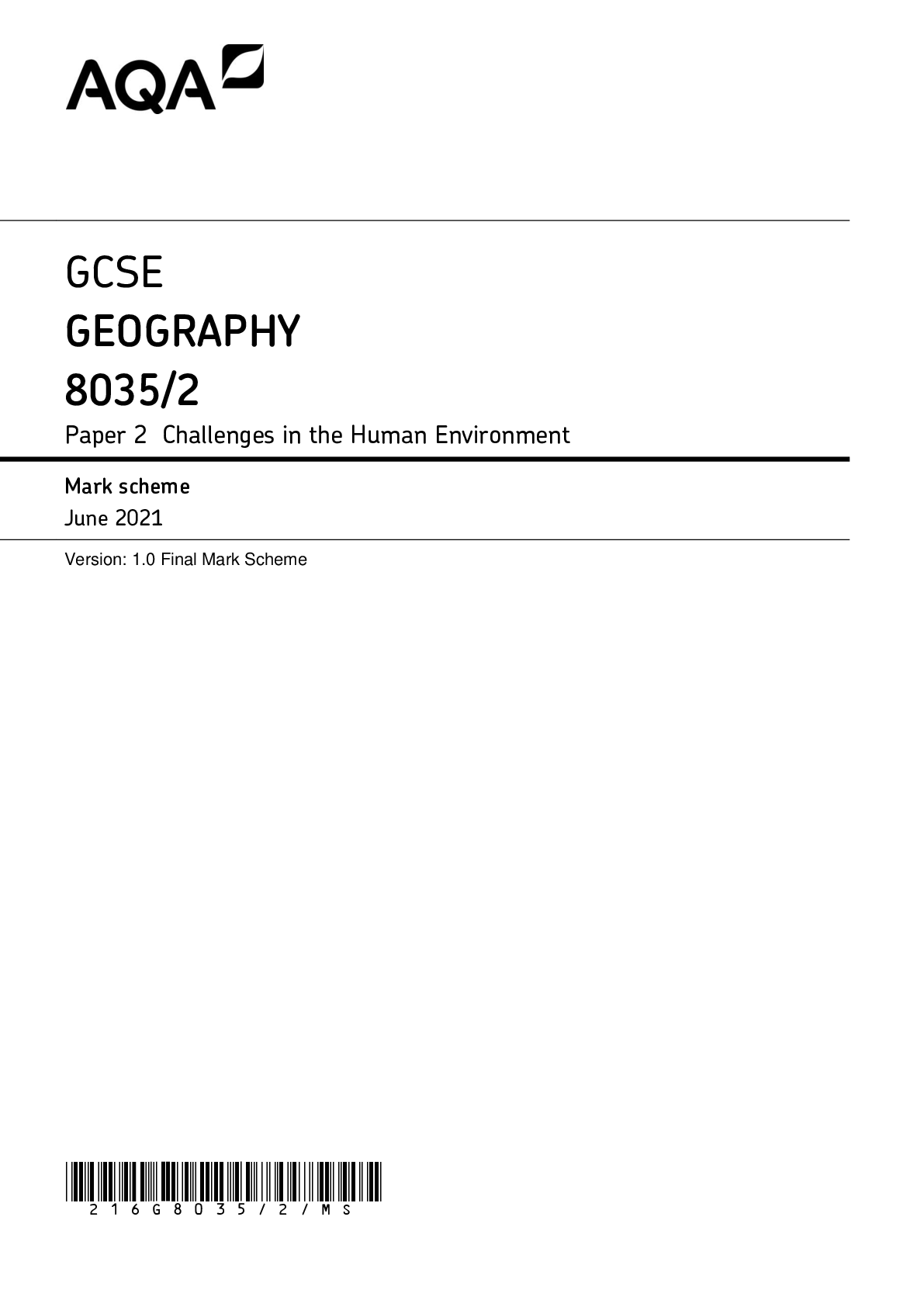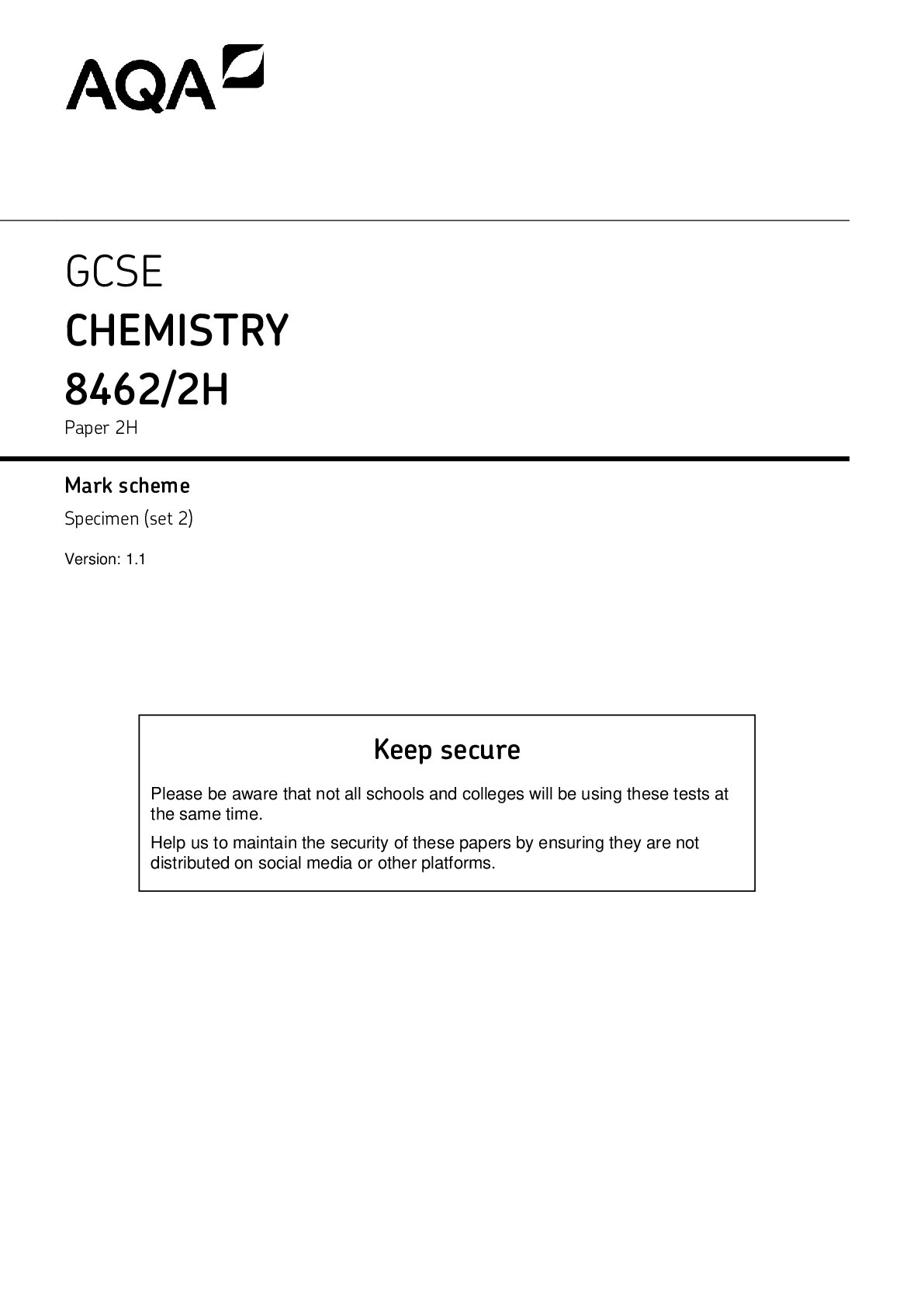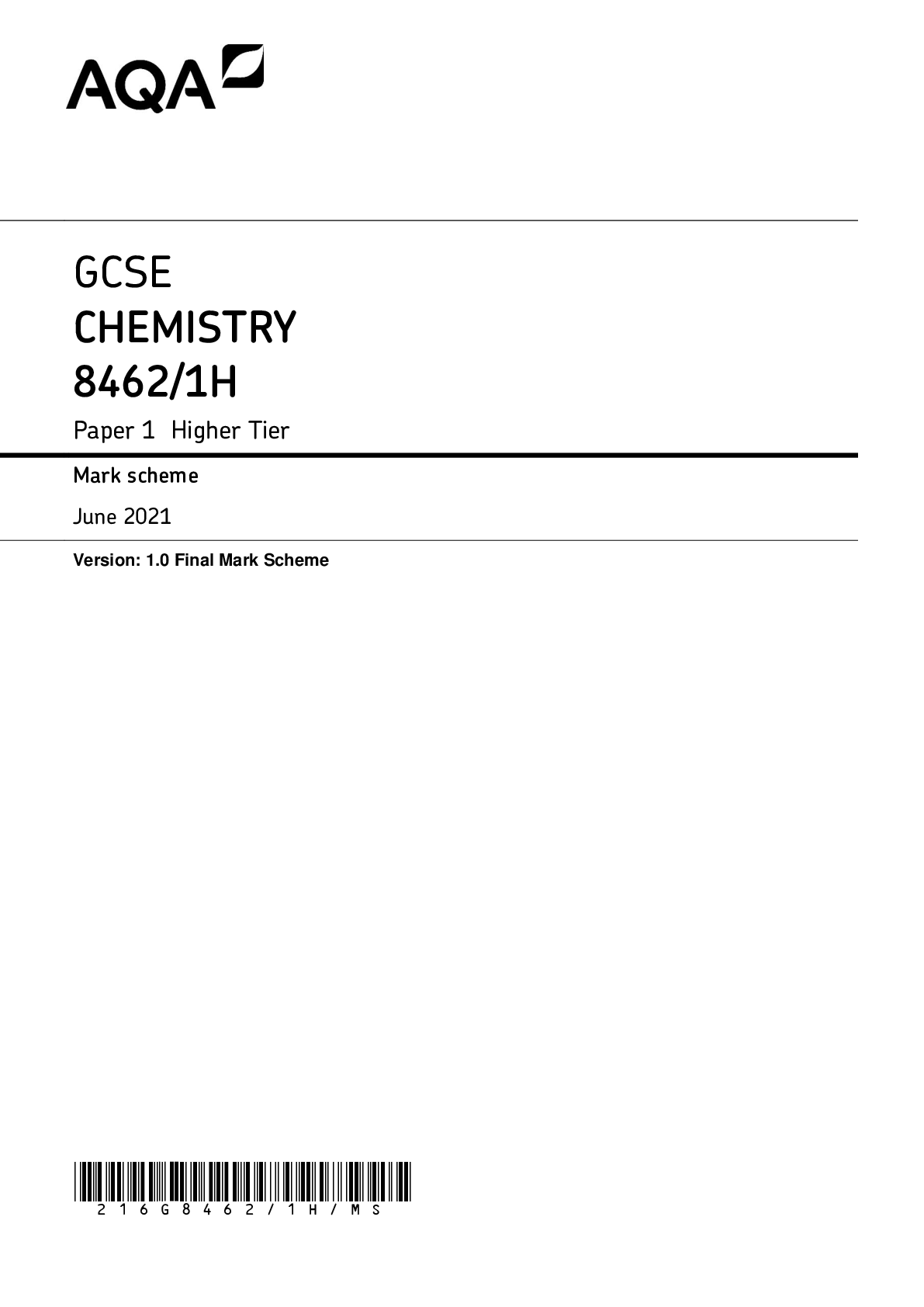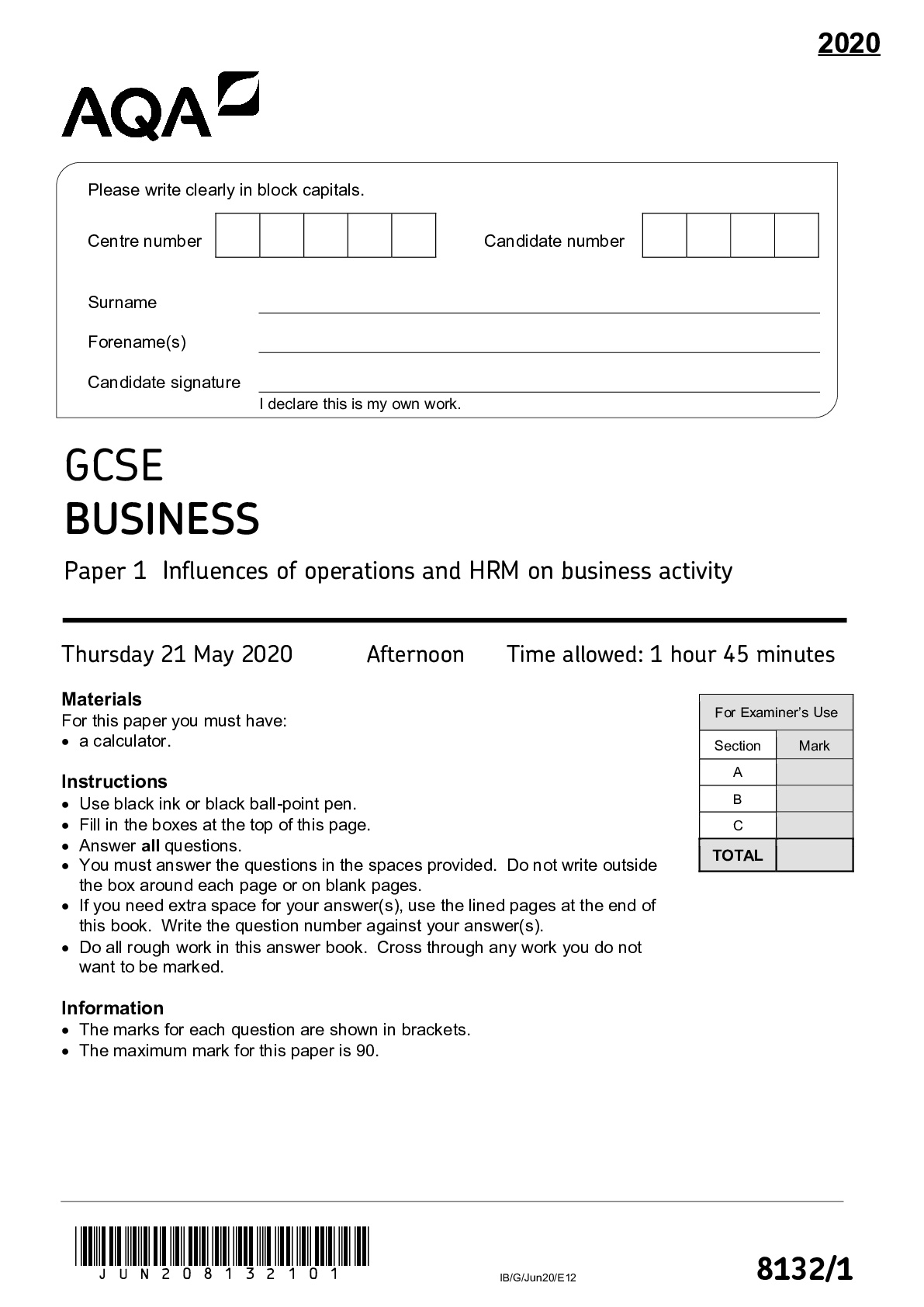Physics > GCSE MARK SCHEME > Forces Practice Calculations ANSWERGSCSE Physics. QUESTIONS WITH ACCURATELY CALCULATED ANSWERS (All)
Forces Practice Calculations ANSWERGSCSE Physics. QUESTIONS WITH ACCURATELY CALCULATED ANSWERS
Document Content and Description Below
1. Calculate the weight of an object which has a mass of 2900 g. Mass in g so must be converted to kg W = m x g W = (2900/1000) x 9.8 W = 28 N 2. Calculate the work done by a force of 4300 N in... moving an object 540 m. Note that weight and work done use the same symbol, W. Be careful to avoid confusion. W = F x s W = 4300 x 540 W = 2,300,000 N 3. Calculate the spring constant of a spring which has an extension of 11 cm when a force of 25 N is applied. Length in cm must be converted to m F = k x e 25 = k x (11/100) k = 230 N/m 4. Calculate the average speed of an object that moves 160 m in 28 s then 420 m in 69 s. Total distance travelled and total time v = s/t v = (160 + 420)/(28 + 69) v = 6 m/s 5. Calculate the change in pressure when an object moves from a depth of 6 m to a depth of 35 m. Can be done as a single calculation using the difference in depth, rather than two separate pressure calculations. Δp = Δh x ρ x g Δp = (35 - 6) x 1000 x 9.8 Δp = 280,000 Pa 6. Calculate the acceleration of an object that goes from 11 m/s to 77 m/s in 10 s. Note that there is more than one equation that can be used to calculate acceleration, depending on the other values given. a = Δv / t a = (77 - 11) / 10 a = 6.6 m/s2 7. Calculate the acceleration of an object that goes from 10 m/s to 20 m/s while travelling a distance of 79 m. v2 – u2 = 2 x a x s 202 - 102 = 2 x a x 79 a = (202 - 102) / (2 x 79) a = 1.9 m/s2 8. Calculate the inertial mass of an object that accelerates at 8.1 m/s2 when a resultant force of 91 N is applied. For the purposes of a calculation, ‘inertial mass’ is just ‘mass’. F = m x a 91 = m x 8.1 m = 11 kg 9. Calculate the momentum of an object with a mass of 450 kg travelling at a velocity of 16 m/s. p = m x v p = 450 x 16 p = 7,200 kg m/s 10. Calculate the resultant force on a 90 kg object that accelerates from 15 m/s to 50 m/s in 2.4 s. This can be done using separate calculations, or using this equation from the data sheet. F = mΔv / t F = 90 x (50 - 15) / 2.4 F = 1,300 N 11. Calculate the force applied to a round surface with a diameter of 46 cm when it is experiencing a pressure of 240 kPa. The pressure in kPa must be converted to Pa, and the diameter used as a radius in m to calculate surface area. P = F / A 240 x 1000 = F / (π x 0.232) F = 40,000 N 12. Calculate the turning moment due to a force of 5.4 N applied 40 cm from a pivot. The distance in cm must be converted to m. M = F x d M = 5.4 x (40/100) M = 2.2 Nm13. Calculate the force, F, acting on the balanced system below. The distances can be left in cm, because the units are the same on both sides of the equation. anticlockwise moment = clockwise moment F x d = F x d 18 x 34 = F x 14 F = 44 N 14. Calculate the distance, d, required to balance the system below. The distances can be left in cm, because the units are the same on both sides of the equation. anticlockwise moment = clockwise moment F x d = F x d 11 x 39 = 26 x d d = 17 cm 15. The objects below collide and move off as a single object. Calculate the velocity after the collision. Total momentum before = total momentum after total momentum before = m1 x v1 + m2 x v2 = 1000 x 15 + 1700 x 8 = 28600 kg m/s total momentum after = (m1 + m2) x v 28600 = (1000 + 1700) x v v = 11 m/s 16. Use the graph to determine (a) the speed in each of the two sections and (b) the average speed for the whole journey. (a) calculate gradient = Δy / Δx speed 1 = (31-0) / (40-0) = 0.78 m/s speed 2 = (14-34) / (80-40) = 0.35 m/s (b) average speed = total distance / total time v = s / t v = 45 / 80 = 0.56 m/s 17. Use the graph to determine the (a) initial acceleration and (b) the distance travelled. (a) calculate gradient = Δy / Δx a = (15-0) / (15-0) = 1.0 m/s2 (b) distance = area under graph total area = area of triangle + area of rectangle distance = ½ x 15 x 15 + 15 x (20-15) = 190 m distance (m) time (s) velocity (m/s) time (s) 18 N F 34 cm 14 cm 11 N 39 cm d 26 N 15 m/s 8 m/s 1000 kg 1700 kg 45 31 40 80 15 15 20GCSE Physics Forces Practice Calculations ANSWERS Sheet 2 All final answers must be correct quoted to 2 significant figures, with the correct units. 1. Calculate the weight of an object which has a mass of 4600 g. Mass in g so must be converted to kg W = m x g W = (4600/1000) x 9.8 W = 45 N 2. Calculate the work done by a force of 3800 N in moving an object 120 m. Note that weight and work done use the same symbol, W. Be careful to avoid confusion. W = F x s W = 3800 x 120 W = 460,000 N 3. Calculate the spring constant of a spring which has an extension of 8 cm when a force of 10 N is applied. Length in cm must be converted to m F = k x e 10 = k x (8/100) k = 130 N/m 4. Calculate the average speed of an object that moves 190 m in 11 s then 470 m in 54 s. Total distance travelled and total time v = s/t v = (190 + 470)/(11 + 54) v = 10 m/s 5. Calculate the change in pressure when an object moves from a depth of 7 m to a depth of 29 m. Can be done as a single calculation using the difference in depth, rather than two separate pressure calculations. Δp = Δh x ρ x g Δp = (29 - 7) x 1000 x 9.8 Δp = 220,000 Pa 6. Calculate the acceleration of an object that goes from 7 m/s to 56 m/s in 6 s. Note that there is more than one equation that can be used to calculate acceleration, depending on the other values given. a = Δv / t a = (56 - 7) / 6 a = 8.2 m/s2 7. Calculate the acceleration of an object that goes from 19 m/s to 55 m/s while travelling a distance of 83 m. v2 – u2 = 2 x a x s 552 - 192 = 2 x a x 83 a = (552 - 192) / (2 x 83) a = 16 m/s2 8. Calculate the inertial mass of an object that accelerates at 5.7 m/s2 when a resultant force of 96 N is applied. For the purposes of a calculation, ‘inertial mass’ is just ‘mass’. F = m x a 96 = m x 5.7 m = 17 kg 9. Calculate the momentum of an object with a mass of 560 kg travelling at a velocity of 12 m/s. p = m x v p = 560 x 12 p = 6,700 kg m/s 10. Calculate the resultant force on a 180 kg object that accelerates from 7 m/s to 58 m/s in 3.7 s. This can be done using separate calculations, or using this equation from the data sheet. F = mΔv / t F = 180 x (58 - 7) / 3.7 F = 2,500 N 11. Calculate the force applied to a round surface with a diameter of 60 cm when it is experiencing a pressure of 180 kPa. The pressure in kPa must be converted to Pa, and the diameter used as a radius in m to calculate surface area. P = F / A 180 x 1000 = F / (π x 0.302) F = 51,000 N 12. Calculate the turning moment due to a force of 6.7 N applied 31 cm from a pivot. The distance in cm must be converted to m. M = F x d M = 6.7 x (31/100) M = 2.1 Nm13. Calculate the force, F, acting on the balanced system below. The distances can be left in cm, because the units are the same on both sides of the equation. anticlockwise moment = clockwise moment F x d = F x d 46 x 31 = F x 16 F = 89 N 14. Calculate the distance, d, required to balance the system below. The distances can be left in cm, because the units are the same on both sides of the equation. anticlockwise moment = clockwise moment F x d = F x d 18 x 31 = 34 x d d = 16 cm 15. The objects below collide and move off as a single object. Calculate the velocity after the collision. Total momentum before = total momentum after total momentum before = m1 x v1 + m2 x v2 = 1200 x 23 + 1300 x 16 = 48400 kg m/s total momentum after = (m1 + m2) x v 48400 = (1200 + 1300) x v v = 19 m/s 16. Use the graph to determine (a) the speed in each of the two sections and (b) the average speed for the whole journey. (a) calculate gradient = Δy / Δx speed 1 = (34-0) / (5-0) = 6.8 m/s speed 2 = (16-31) / (40-5) = 0.40 m/s (b) average speed = total distance / total time v = s / t v = 48 / 40 = 1.2 m/s 17. Use the graph to determine the (a) initial acceleration and (b) the distance travelled. (a) calculate gradient = Δy / Δx a = (45-0) / (10-0) = 4.5 m/s2 (b) distance = area under graph total area = area of triangle + area of rectangle distance = ½ x 45 x 10 + 45 x (15-10) = 450 m distance (m) time (s) velocity (m/s) time (s) 46 N F 31 cm 16 cm 18 N 31 cm d 34 N 23 m/s 16 m/s 1200 kg 1300 kg 48 34 5 40 45 10 [Show More]
Last updated: 1 year ago
Preview 1 out of 202 pages

Reviews( 0 )
Document information
Connected school, study & course
About the document
Uploaded On
Jun 07, 2022
Number of pages
202
Written in
Additional information
This document has been written for:
Uploaded
Jun 07, 2022
Downloads
0
Views
112

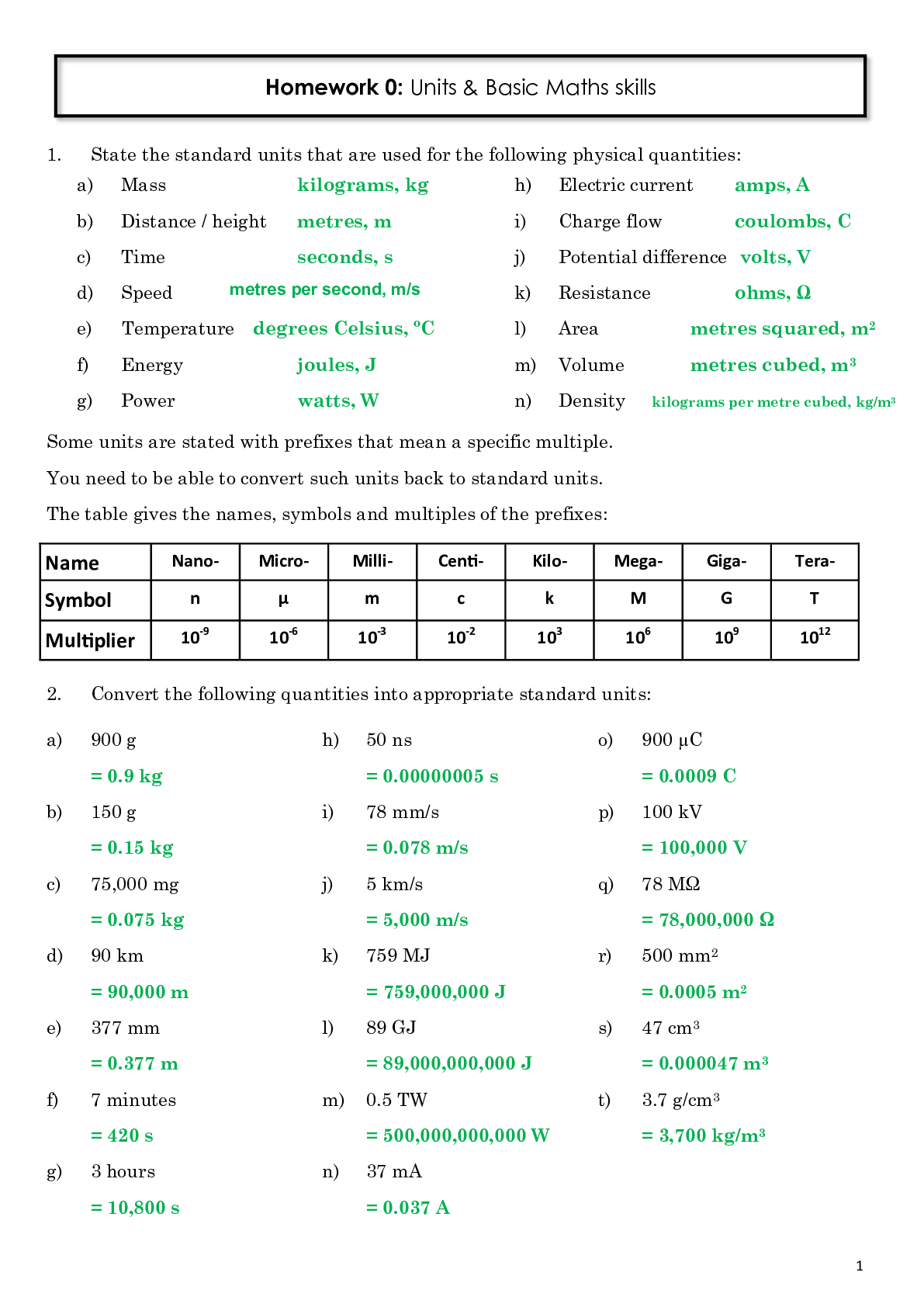



.png)
.png)

.png)
.png)
.png)
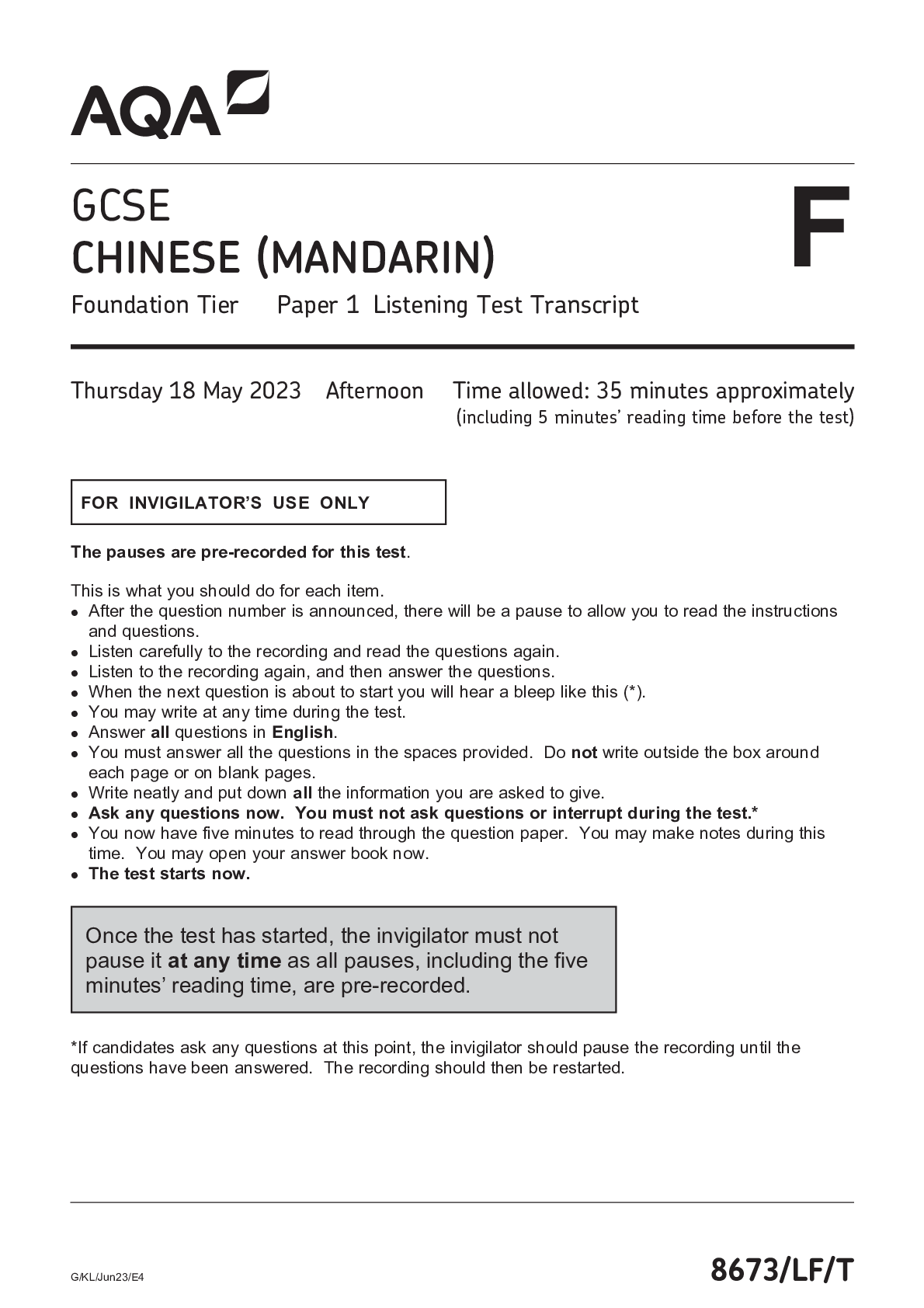
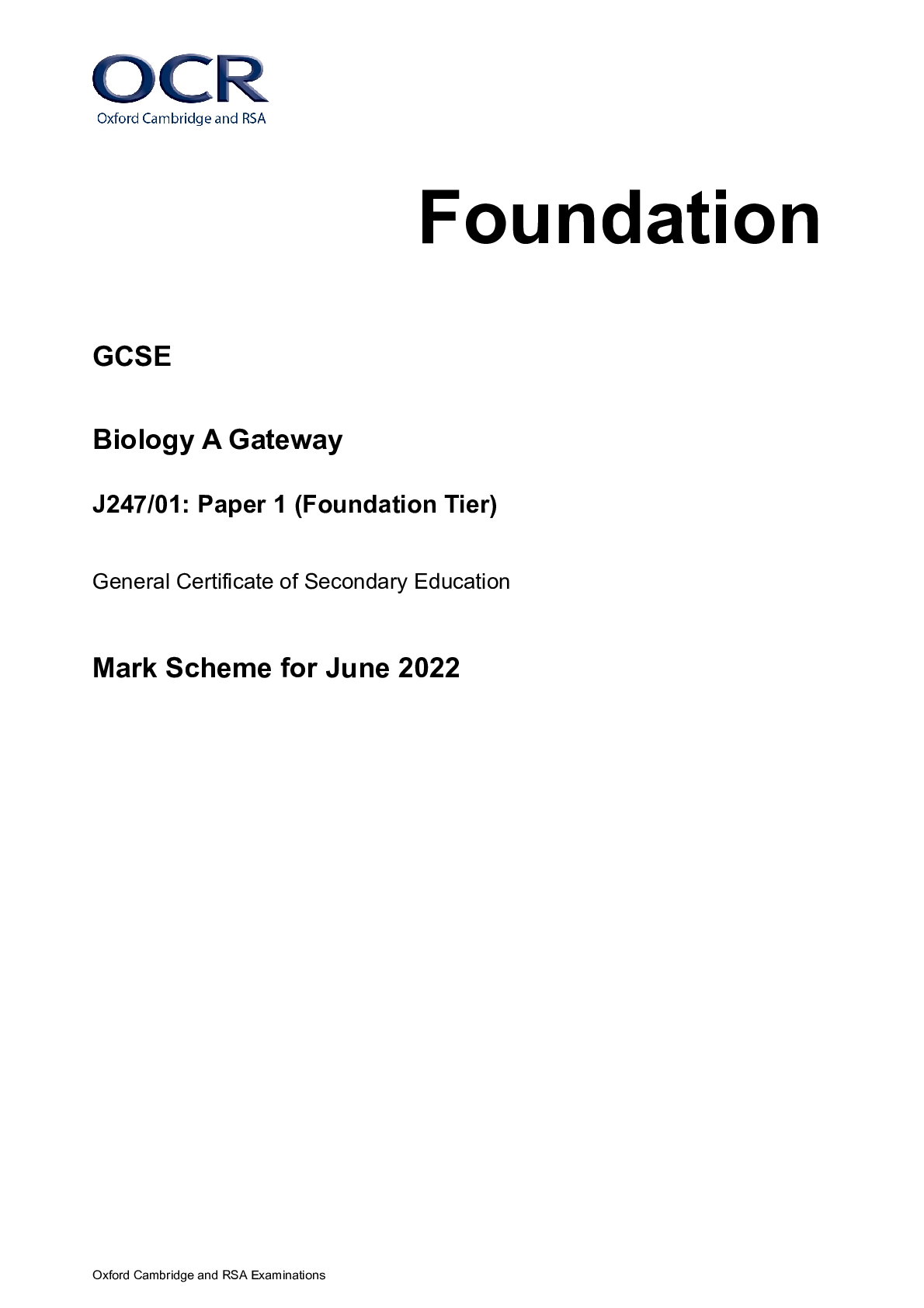
H630-02 Pure Mathematics and Statistics Advanced Subsidiary GCE Mark Scheme for Autumn 2021.png)

.png)
.png)
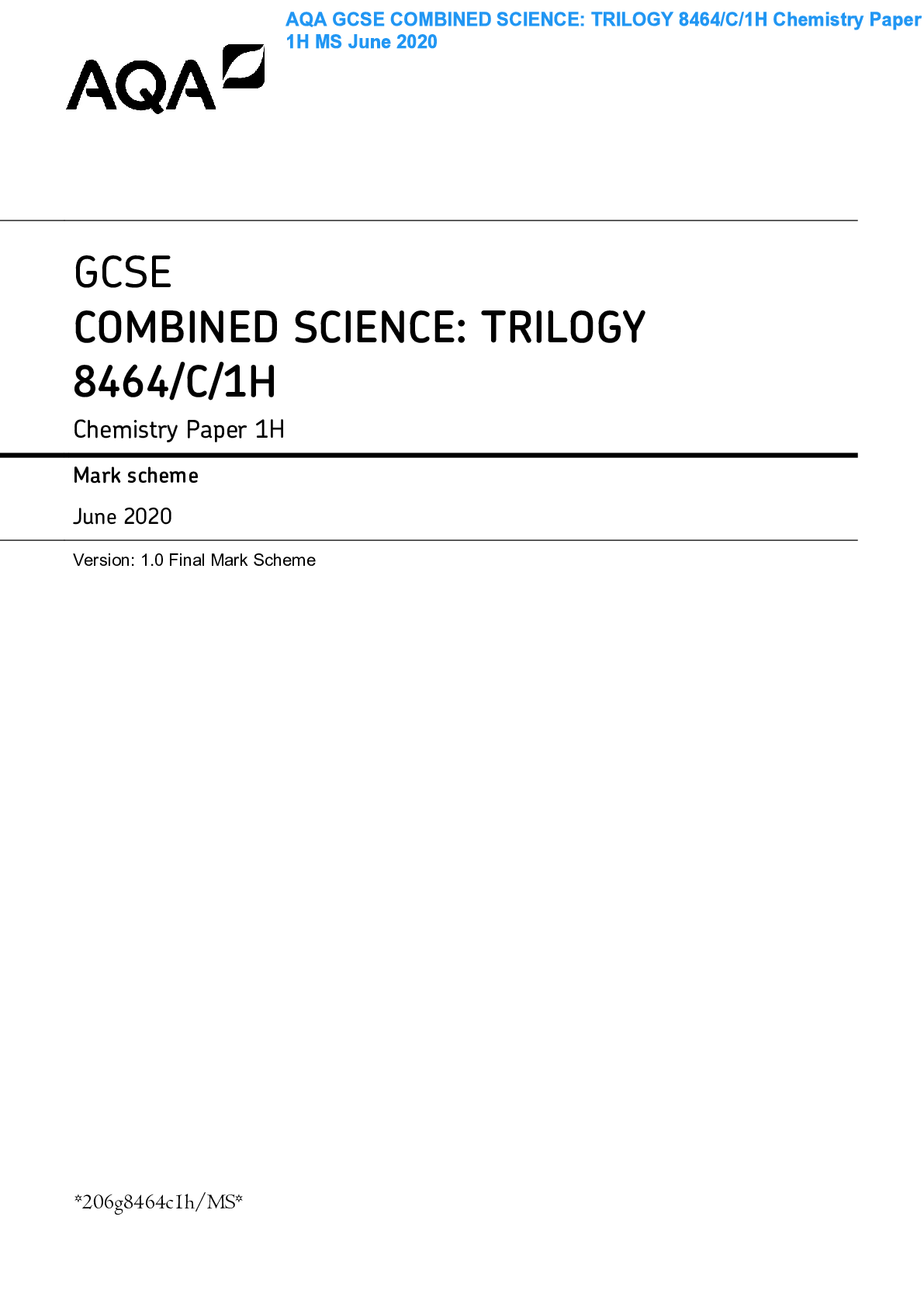
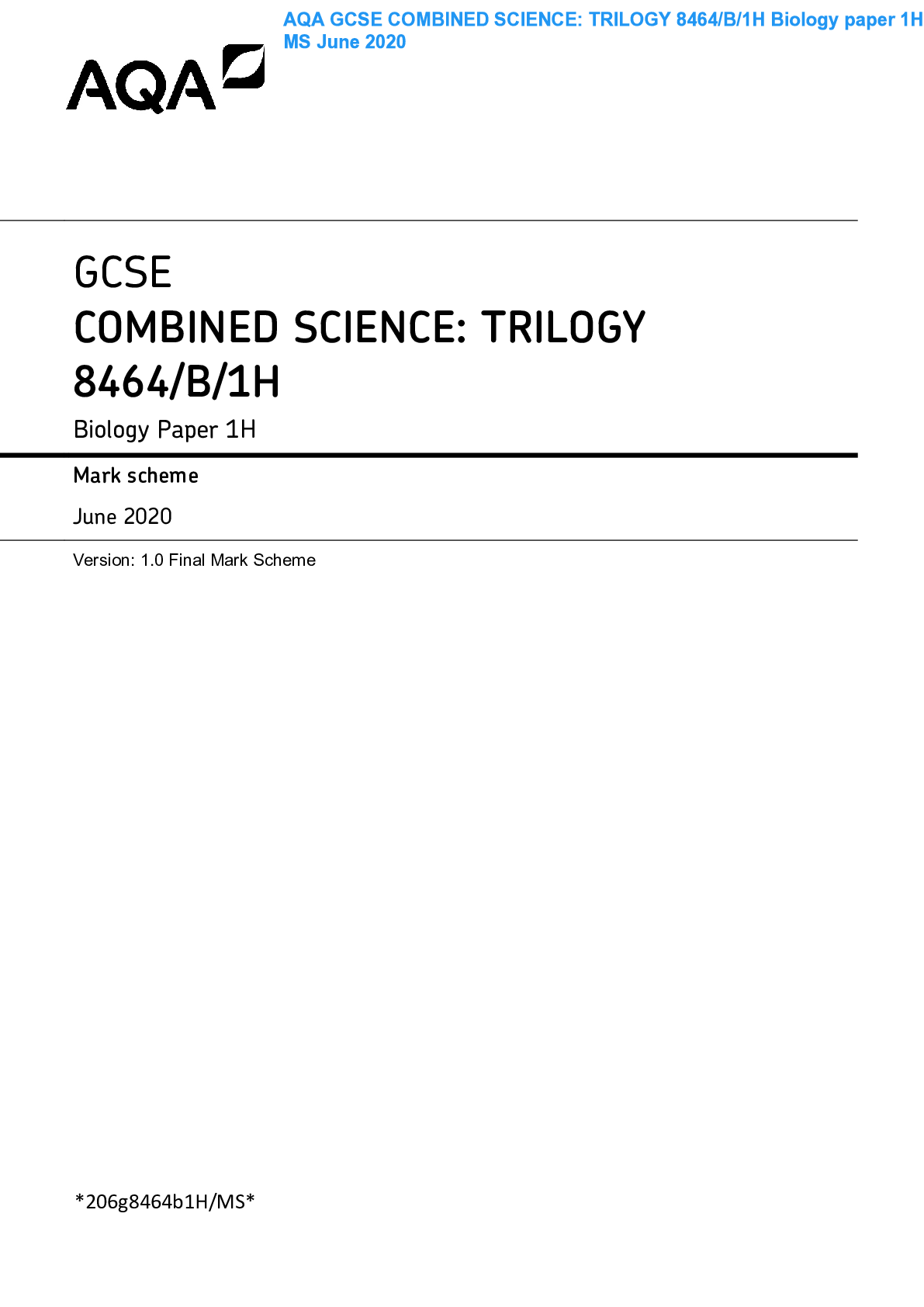
.png)
In Mathematics (1MA1).png)
